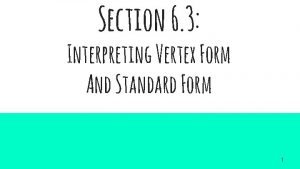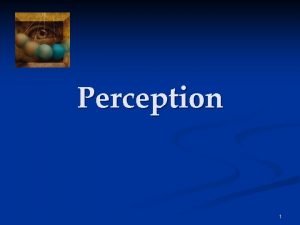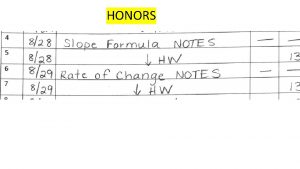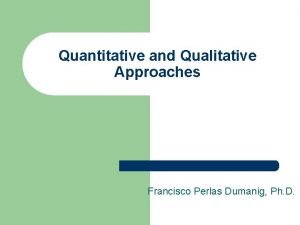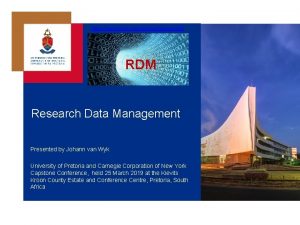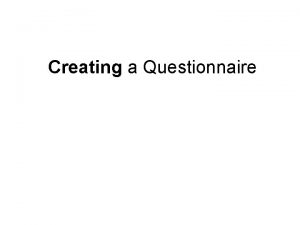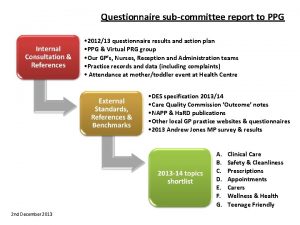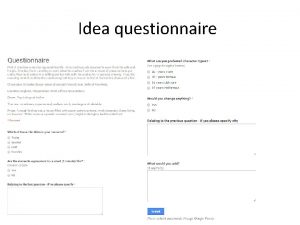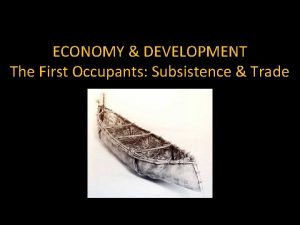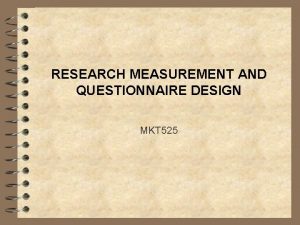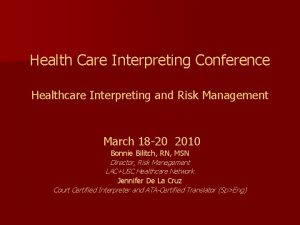Interviewing Occupants Questionnaire Development and Interpreting Results Interviewing


















- Slides: 18

Interviewing Occupants, Questionnaire Development and Interpreting Results

Interviewing Occupants, Questionnaire Development and Interpreting Results

Interviewing Occupants, Questionnaire Development and Interpreting Results The initial mold inspection is the most important part of the mold removal process. This is where a mold inspectors skill, knowledge & training come into play

Possible Questions • Have you seen any visible mold growth? • Have you noticed any odors or water accumulations (flooding, roof leaks, or condensation)? • Have you/family members experienced any mold related symptoms? • Where is the HVAC system located?

Sample Occupant Interview Form

Sample Occupant Interview Form

Moisture Event Report Sample

Environmental Assessment 1. Visual Inspection 2. Measurement equipment 3. Bulk/Surface Sampling 4. Air Monitoring 5. Analysis of Environmental Samples

Understanding Lab Results Guidance for interperetation of mold laboratory test results; – The final mold interpretation should not be based solely on numbers! Information gathered from a walk-through investigation of the area is very significant, including sources of moisture or high humidity, and signs of visible mold growth. – When evaluating air samples, it is important to consider the type of concentration of fungi indoors, as compared to outdoors or a non-complaint area.

Understanding Lab Results • One must consider the indoor/outdoor fungal count ratio, the presence or absence of certain fungi indoors versus outdoors, the genus or species of predominant fungi indoors versus outdoors, and whether the fungi detected indoors are allergenic and or toxic.

Understanding Lab Results • It is important to note that there are no governmental-issued numerical standards for mold interpretation. However, some environmental companies, industrial hygienists, and other IAQ professionals use the following arbitrary numbers for guidance in interpreting microbial survey results.

Bio-aerosol (Air Samples) <250 CFU/m 3 Low to Normal 250 -1, 000 CFU/m 3 Moderate to Borderline CFU/m 3 Active Growth to Sporulation CFU/m 3 Very Active Growth to Sporulation >1, 000 >5000

Swab Samples • • ND <10 101 -100 >1, 000 None Detected Spores Rare Light Heavy



Mold Analysis Report Wall Cavity


 Creating and interpreting graphs and tables
Creating and interpreting graphs and tables Interpreting graphs science
Interpreting graphs science Drawing and interpreting graphs
Drawing and interpreting graphs Quadratic function
Quadratic function Selecting organizing and interpreting information
Selecting organizing and interpreting information Analyzing and interpreting quantitative data
Analyzing and interpreting quantitative data Is the slope the rate of change
Is the slope the rate of change Planning recording analyzing and interpreting
Planning recording analyzing and interpreting Analyzing and interpreting data in research
Analyzing and interpreting data in research Analyzing and interpreting data in research
Analyzing and interpreting data in research Analyzing and interpreting data in research
Analyzing and interpreting data in research Barking up the wrong tree sentence
Barking up the wrong tree sentence Analyzing and interpreting data in research
Analyzing and interpreting data in research Analyzing and interpreting data in research
Analyzing and interpreting data in research Analyzing and interpreting literature
Analyzing and interpreting literature Interpreting distance time graphs
Interpreting distance time graphs Creating and interpreting distance time graph
Creating and interpreting distance time graph What kind of graph is this
What kind of graph is this Analyzing and interpreting data
Analyzing and interpreting data



